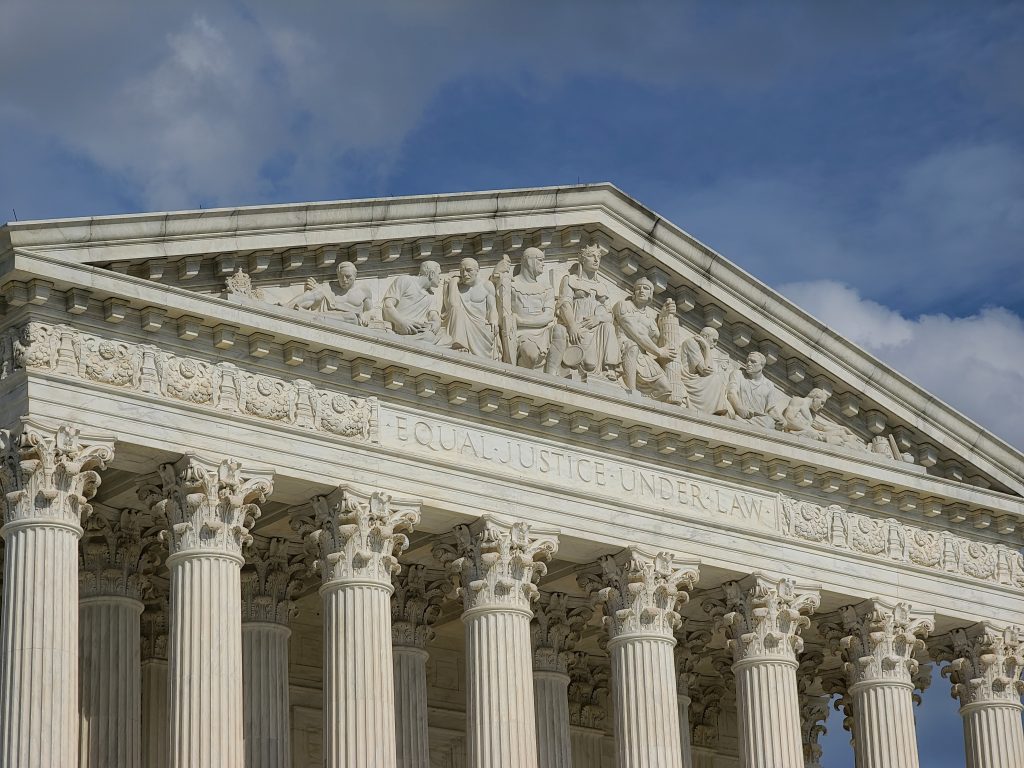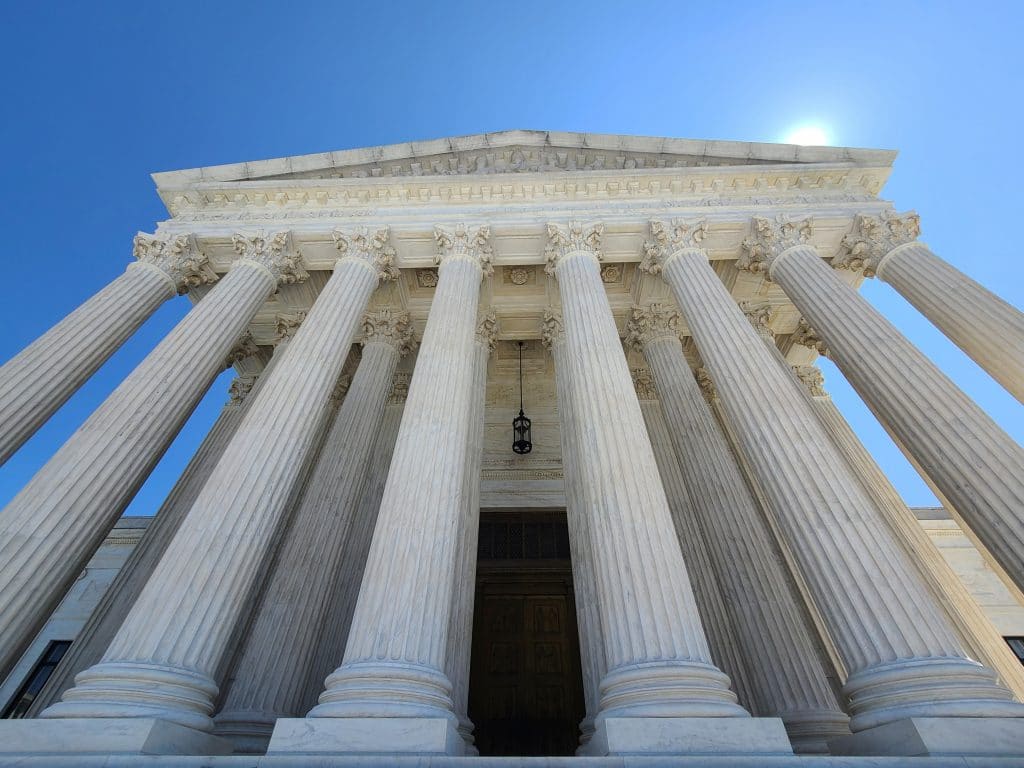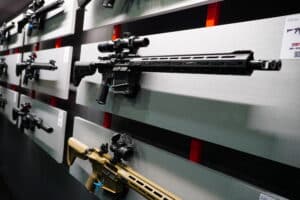It’s only been a year since the Supreme Court handed down a landmark Second Amendment decision. Now, it’s going back to the issue.
That marks a much faster pace for taking gun cases than ever before. And it gives some further insight into how disruptive the landmark Bruen decision has been. But the new case is not the kind gun-rights groups have been pushing for the Court to take up and its outcome is far from clear.
Perhaps the Supreme Court will also shine new light on what the beginning point for an acceptable “historical tradition” of gun regulation should be. Contributing Writer Jake Fogleman lays out how lower courts are addressing that exact dilemma so far.
Plus, a rabbi with the New York State Jewish Gun Club joins the podcast to discuss a federal judge’s ruling in favor of the state’s synagogue gun ban.

Supreme Court Agrees to Take Up New Gun Case
By Stephen Gutowski
The nation’s highest court has agreed to hear another Second Amendment case just a year after it handed down a landmark decision that forged a new test for the constitutionality of gun laws.
On Friday, the Supreme Court granted review in United States v. Rahimi. In February, a Fifth Circuit Court of Appeals panel ruled the prohibition on owning guns while being subject to a domestic violence restraining order is unconstitutional. The Department of Justice (DOJ) appealed that decision, and now the Court will now take up that same question.
The case marks a sustained uptick in the Court’s appetite for Second Amendment cases. While the Court has only considered seven major Second Amendment cases, with one being mooted and another being a unanimous per curiam opinion, three of those seven have come in the last three years. With 2022’s New York State Rifle and Pistol Association v. Bruen creating a new Second Amendment test the Court will likely have reason to take even more gun cases in the future as circuit splits develop over how to properly apply the new test.
Rahimi is not a case brought or backed by gun-rights groups. Instead, it stems from the conviction of a Texas man. Zachary Rahimi admitted to possessing guns in violation of a restraining order taken out against him by the mother of his child that was the result of “family violence.” Police discovered the guns after searching his residence in the aftermath of multiple other crimes Rahimi allegedly committed, including multiple shootings. In court filings, DOJ said he has been accused of taking part in at least five different shootings over the course of six weeks between December 2020 and January 2021. Those incidents ranged from Rahimi shooting at someone he’s also accused of selling Percocet to, shooting at another person he cut off in traffic, and firing a gun into the air at a Whataburger because his friend’s credit card had been declined.
Charges are being pursued in those other incidents that, if Rahimi is convicted, would also lead to the loss of his gun rights. However, the charge at issue in the Supreme Court case is only related to his possession of guns while under the domestic violence restraining order.
On that point, the Fifth Circuit panel found there was insufficient evidence that the restraining order restriction was part of the “historical tradition” of gun regulation, as required under Bruen’s test.
“The Government fails to demonstrate that § 922(g)(8) ‘s restriction of the Second Amendment right fits within our Nation’s historical tradition of firearm regulation. The Government’s proffered analogues falter under one or both of the metrics the Supreme Court articulated in Bruen as the baseline for measuring ‘relevantly similar’ analogues: ‘how and why the regulations burden a law-abiding citizen’s right to armed self-defense,’” Judge Cory T. Wilson wrote for the panel in United States v. Rahimi. “As a result, § 922(g)(8) falls outside the class of firearm regulations countenanced by the Second Amendment.”
The decision reversed the Fifth Circuit’s previous decisions on domestic violence restraining orders where the court had upheld convictions under the same law. The reversal is the result of the Supreme Court rejecting the previous test the court had used to come to that conclusion. In its review under the new test, the panel concluded that, no matter how well-intentioned the gun ban was, it is incompatible with the Second Amendment.
“Doubtless, 18 U.S.C. § 922(g)(8) embodies salutary policy goals meant to protect vulnerable people in our society,” Judge Wilson wrote. “Weighing those policy goals’ merits through the sort of means-end scrutiny our prior precedent indulged, we previously concluded that the societal benefits of § 922(g)(8) outweighed its burden on Rahimi’s Second Amendment rights. But Bruen forecloses any such analysis in favor of a historical analogical inquiry into the scope of the allowable burden on the Second Amendment right. Through that lens, we conclude that § 922(g)(8)’s ban on possession of firearms is an ‘outlier that our ancestors would never have accepted.’ Therefore, the statute is unconstitutional, and Rahimi’s conviction under that statute must be vacated.”
The judges looked at how historical laws had handled similar situations. They examined laws that disarmed groups of people–usually racial minorities–that were perceived as dangerous, laws that banned anyone from “going armed to the terror of the people,” and laws that required specific people who were accused of being dangerous to post a cash “surety” before being allowed to carry in public. But they determined none of those laws were close enough to the modern example to pass muster.
“[O]n substance, the early ‘going armed’ laws that led to weapons forfeiture are not relevantly similar to § 922(g)(8),” Judge Wilson wrote. “First, those laws only disarmed an offender after criminal proceedings and conviction. By contrast, § 922(g)(8) disarms people who have merely been civilly adjudicated to be a threat to another person. Moreover, the ‘going armed’ laws, like the ‘dangerousness’ laws discussed above, appear to have been aimed at curbing terroristic or riotous behavior, i.e., disarming those who had been adjudicated to be a threat to society generally, rather than to identified individuals.”
The judges said “surety” laws came closest to the restraining order law, but were still too different.
“The surety laws required only a civil proceeding, not a criminal conviction,” they said. “The ‘credible threat’ finding required to trigger § 922(g)(8) ‘s prohibition on possession of weapons echoes the showing that was required to justify posting of surety to avoid forfeiture. But that is where the analogy breaks down: As the Government acknowledges, historical surety laws did not prohibit public carry, much less possession of weapons, so long as the offender posted surety.”
Ultimately, they found there weren’t any historical analogues of the type required by Bruen for a total prohibition on gun ownership based on a restraining order. So, they tossed Rahimi’s conviction.
Judge James C. Ho defended the panel’s position in a concurrence. He suggested there are more appropriate means to hold people like Rahimi responsible for their actions. He argued the right to keep and bear arms is “entirely compatible” with the “fundamental role of government in protecting citizens against violence,” even if the Second Amendment precludes gun bans based on restraining orders.
“Our Founders understood that those who commit or threaten violence against innocent law-abiding citizens may be arrested, convicted, and incarcerated,” he wrote. “They knew that arrest and incarceration naturally entails the loss of a wide range of liberties—including the loss of access to arms.”
He argued if the government wants to disarm someone, “it must do so consistent with the fundamental protections that our Constitution affords to those accused of a crime.” He noted that was possible for those who merely threaten violence too. But he said the accused have to be given appropriate protections for their rights.
“Pre-trial detention is expressly contemplated by the Excessive Bail Clause and the Speedy Trial Clause. And it no doubt plays a significant role in protecting innocent citizens against violence,” Judge Ho said. “Our laws also contemplate the incarceration of those who criminally threaten, but have not (yet) committed, violence. After all, to the victim, such actions are not only life-threatening—they’re life-altering.”
The question of who the government can and can’t prohibit from owning guns has been at the core of many challenges in the wake of the Bruen decision. And it’s one that has seen judges offer diametrically opposed opinions on the constitutionality of a given provision.
Earlier this month, the full panel of the Third Circuit ruled a Pennsylvania man’s felony-level conviction for food stamp fraud in the 1990s couldn’t prohibit him from owning guns for life.
“We agree with Range that, despite his false statement conviction, he remains among ‘the people’ protected by the Second Amendment,” Judge Thomas Hardiman wrote for an 11-4 majority in Range v. Attorney General. “And because the Government did not carry its burden of showing that our Nation’s history and tradition of firearm regulation support disarming Range, we will reverse and remand.”
That ruling happened just weeks after a three-judge panel for the Eighth Circuit came to the opposite conclusion in the case of a Minnesota man who is barred from owning guns for previous drug convictions.
“Given these assurances by the Supreme Court, and the history that supports them, we conclude that there is no need for felony-by-felony litigation regarding the constitutionality of § 922(g)(1),” Judge Steven Colloton, a George W. Bush appointee, wrote in his opinion.
That court relied heavily on non-binding dicta the Supreme Court has offered in its Second Amendment rulings, such as 2008’s District of Columbia v. Heller–a message Justice Kavanaugh referenced in his Bruen concurrence.
“Although we do not undertake an exhaustive historical analysis today of the full scope of the Second Amendment,” Justice Antonin Scalia wrote for the majority, “nothing in our opinion should be taken to cast doubt on longstanding prohibitions on the possession of firearms by felons and the mentally ill, or laws forbidding the carrying of firearms in sensitive places such as schools and government buildings, or laws imposing conditions and qualifications on the commercial sale of arms.”
In the federal district courts, there have been a dozen more rulings that have come down on either side of the question over who can and can’t be prohibited from owning guns under Bruen and for how long that prohibition can last. Now, the Supreme Court will take its best shot at trying to iron out some of these disagreements.

Analysis: The Supreme Court Could Go Either Way in New Gun Case [Member Exclusive]
By Stephen Gutowski
On Friday, the Supreme Court agreed to hear a new Second Amendment case. Despite the justices’ ideological leanings, it’s unclear how they will rule for several reasons.
The Court will take up United States v. Rahimi in its October term. A Fifth Circuit panel ruled back in February that Zachary Rahimi’s conviction for possessing guns while under a domestic violence restraining order violated his Second Amendment rights. The Department of Justice appealed, and the Court accepted.
Usually, one sign of how the Court might rule is that they’re more likely than not to take up a case with a decision they wish to overturn. However, in this case, that’s less of an indicator because the Court is also more likely than not to take up a case where a federal law has been invalidated.
The legal and political implications of the case provide a better guide for how things might go. But those factors aren’t as easy to read when trying to determine an outcome.
This is a case with a very unsympathetic plaintiff that hasn’t been backed by any gun-rights groups. And the public is unlikely to be on Rahimi’s side either. At the same time, the Supreme Court’s Second Amendment test may be.
According to court documents, Rahimi was subject to a restraining order due to “family violence” against the mother of his child. He admitted to owning guns in violation of the order and federal law after police searched his home due to the multiple other crimes, including several shootings, he is accused of committing.
Between December 2020 and January 2021, Rahimi is accused of taking part in five different shootings. He is facing charges for shooting at somebody he had earlier sold drugs to, shooting at someone he cut off in traffic, and firing a gun in the air at a Whataburger after his friend’s credit card was declined. Any of those charges could also result in the Texas man losing his gun rights as well.
But they aren’t at issue in the Supreme Court case against him. That he’s a bad guy who has been accused of multiple shootings and domestic violence shouldn’t have an impact of the legal case against him. But it still might.
After all, there’s a reason gun-rights advocates haven’t prioritized fighting this particular restriction and have instead focused on “assault weapon” bans and gun-carry restrictions. Gun bans for domestic violence perpetrators are broadly popular; expanding them was even part of last year’s federal gun-control bill. And there’s good reason for that since perps often re-offend or even escalate their violence.
To this point, the Supreme Court has been unwilling to get ahead of the American public on gun policy. When the Court found the Second Amendment forstalled a total ban on handguns in 2008, handgun bans were deeply unpopular and nearly extinct. When it ruled the government can’t deny gun-carry permits to qualified applicants on a subjective basis, the carry revolution had already pushed 42 states to that point or even gotten them to eliminate permitting altogether.
The opposite can be said for domestic-violence-related gun restrictions.
2022’s New York State Rifle and Pistol Association v. Bruen was a six-to-three decision on the key question over whether the state’s carry law was constitutional and what the future test for gun cases should be. That indicates there’s a certain level of conformity on the Court about gun issues. But, if you a bit look closer, Bruen was more like a three-three-two decision.
That’s because Justice Bret Kavanaugh wrote a concurrence joined by Chief Justice John Roberts that emphasized a limit on Second Amendment protections the majority opinion didn’t, specifically asserting that non-subjective carry permitting is permissible without outlining the historical justification for why. That suggests they may be less than eager to wholesale remove popular gun policies. With the three justices on the left of the bench almost certain to vote against Rahimi, that makes five.
Still, the legal case may lean towards Rahimi. The Fifth Circuit panel’s examination of the historical record, which is what Bruen requires, found there was no tradition of banning those subject to domestic violence restraining orders from owning guns. Namely, it decided the gun regulations that existed at the founding didn’t address the same broad issue, protecting an individual from another individual, with the same punishment, total loss of gun rights.
“The Government fails to demonstrate that § 922(g)(8) ‘s restriction of the Second Amendment right fits within our Nation’s historical tradition of firearm regulation. The Government’s proffered analogues falter under one or both of the metrics the Supreme Court articulated in Bruen as the baseline for measuring ‘relevantly similar’ analogues: ‘how and why the regulations burden a law-abiding citizen’s right to armed self-defense,'” Judge Cory T. Wilson wrote for the panel in United States v. Rahimi. “As a result, § 922(g)(8) falls outside the class of firearm regulations countenanced by the Second Amendment.”
The panel considered laws that disarmed groups of people–usually racial minorities–who were perceived as dangerous, laws against “going armed to the terror of the people,” and “surety” laws that required individuals accused of being dangerous to post a bond before carrying a gun in public. They decided none of those were close enough matches to qualify as analogues.
“[O]n substance, the early ‘going armed’ laws that led to weapons forfeiture are not relevantly similar to § 922(g)(8),” Judge Wilson wrote. “First, those laws only disarmed an offender after criminal proceedings and conviction. By contrast, § 922(g)(8) disarms people who have merely been civilly adjudicated to be a threat to another person. Moreover, the ‘going armed’ laws, like the ‘dangerousness’ laws discussed above, appear to have been aimed at curbing terroristic or riotous behavior, i.e., disarming those who had been adjudicated to be a threat to society generally, rather than to identified individuals.”
Surety laws came the closest, but the panel was unconvinced.
“The surety laws required only a civil proceeding, not a criminal conviction,” the panel said. “The ‘credible threat’ finding required to trigger § 922(g)(8) ‘s prohibition on possession of weapons echoes the showing that was required to justify posting of surety to avoid forfeiture. But that is where the analogy breaks down: As the Government acknowledges, historical surety laws did not prohibit public carry, much less possession of weapons, so long as the offender posted surety.”
Perhaps a majority of the Supreme Court will feel differently on that point. Or maybe they’ll identify another set of historical laws the Fifth Circuit didn’t consider. Or, perhaps, they’ll come to the same conclusion that panel did.
When the Court agreed to hear Bruen, it was fairly clear the justices were going to strike down New York’s law. It was mainly the scope of the ruling that was uncertain. With Rahimi, uncertainty abounds.
Come on the Podcast
One of the many perks of a Reload membership is the opportunity to appear on the podcast. We’ve had a lot of people on the show from all kinds of backgrounds. It’s one of my favorite segments since it gives us all a better insight into the community that makes this publication possible. If you want to come on the show, just reply to this email and let me know!
Podcast: Examining the Ruling Upholding NYC’s Synagogue Gun Ban With a Jewish Gun Club Rabbi [Member Early Access]
By Stephen Gutowski
This week, we’re examining a new ruling in favor of New York’s ban on carrying a concealed gun in places of worship. It’s a somewhat surprising decision that comes after the state already abandoned the total ban and several other judges have struck it down. So, the whole situation is a bit confusing.
That’s why we have New York State Jewish Gun Club member Rabbi Tzvi Hershel Goldstein on the show. He is directly affected by the new ruling, and his group helped fund the case against it.
He argues the ban on worshipers carrying at synagogue violates not just his Second Amendment rights but his First Amendment rights too. He said the group plans to appeal the decision and expects to win at the Second Circuit Court of Appeals, though the slower pace of this case may result in the issue being decided before they get there. Still, Goldstein said the club is willing to take the case all the way to the Supreme Court if necessary.
But that court will have to decide another gun case first.
Contributing Writer Jake Fogleman and I talk about the breaking news that the Supreme Court has agreed to take a new Second Amendment case. We go over the details of the case and try to read some tea leaves on where the Court may come down.
Plus, Reload Member Michael tells us his difficult but important story of struggling with mental health and addiction while being a gun owner.
You can listen to the show on your favorite podcasting app or by clicking here. Video of the episode is available on our YouTube channel. Reload Members get access on Sunday, as always. The show goes public on Monday.

Analysis: What Constitutes a Valid ‘Historical Tradition’ of Gun Regulation? [Member Exclusive]
By Jake Fogleman
A New York federal judge just ruled that the state’s ban on gun possession in churches is likely constitutional. How he got to that decision may be more interesting than the decision itself.
On Wednesday, U.S. District Judge Vernon Broderick denied a request for a preliminary injunction against a provision of New York law deeming all places of worship a “sensitive location” where gun carry is banned. He found that such a ban was consistent with the nation’s historical tradition of gun regulation.
“There is a sufficient historical record to support the finding that houses of worship are sensitive places, where it is constitutionally permissible for the state to regulate the carrying of firearms,” Broderick wrote in Goldstein v. Hochul. “There are both laws that specifically outlaw the carrying of weapons in churches or places of worship, and broader founding era regulations that limit the ability for law-abiding individuals to carry weapons in public generally, which would include inside places of worship.”
That “historical record” of “founding era” regulations Broderick identified relied heavily upon a series of laws, passed primarily in southern states and western territories between 1870-1889, that banned gun carrying into churches and other places of worship. That analysis, with its emphasis on late 19th-century historical analogues, marks a serious departure from how other judges have handled challenges to New York’s law to date.
By contrast, Judge John Sinatra of the Western District of New York—who issued an injunction against the exact same provision upheld by Broderick—explicitly rejected these same historical analogues as “insufficient in the search for an American tradition” of gun carry regulations, precisely because they were from the late 19th century.
“As a result the Court is left…with a handful of seemingly spasmodic enactments involving a small minority of jurisdictions governing a small minority of population,” Judge Sinatra wrote in his injunction order. “And they were passed nearly a century after the Second Amendment’s ratification in 1791. These outlier enactments also contrast with colonial-era enactments that, in fact, mandated such carry at places of worship.”
Here, Sinatra seems to suggest that 1791 is the controlling time period for understanding the Second Amendment and the historical tradition of gun regulations, as he explicitly favors pro-gun-carry laws enacted around the time of the founding over later Reconstruction-era laws prohibiting the same conduct. These competing visions over the relevant history center around which date appropriately demarcates how the Second Amendment is to be properly understood, with starkly different outcomes depending on the time period chosen.
Supporters of a 1791-focused analysis argue that Second Amendment’s meaning is fixed to when the original founders ratified it in the Bill of Rights. Therefore, in this view, any historical tradition of firearms regulation must begin during or before this era to be considered valid.
On the other hand, supporters of an 1868-focused analysis argue that the Fourteenth Amendment’s ratification is what matters. That’s because the Reconstruction-era amendment made all preceding amendments in the Bill of Rights applicable to the states for the first time, according to the Supreme Court’s incorporation doctrine. Therefore, they would argue, the understanding of the Second Amendment and its limits that were in place in state and local governments during this time would be pertinent in determining the proper historical tradition of gun regulation.
The Supreme Court, for its part, appears to have tipped its hand toward a preference for a tradition beginning around the original founding, in 1791. Justice Thomas wrote for the majority in Bruen that the Second Amendment’s “meaning is fixed according to the understandings of those who ratified it.”
“We have made clear that individual rights enumerated in the Bill of Rights and made applicable against the States through the Fourteenth Amendment have the same scope as against the Federal Government,” Thomas wrote. “And we have generally assumed that the scope of the protection applicable to the Federal Government and States is pegged to the public understanding of the right when the Bill of Rights was adopted in 1791.”
However, he did point to a degree of ambiguity regarding whether the historical tradition surrounding the Constitution’s ratification in 1791 or the era of the ratification of the Fourteenth Amendment—which incorporated the Bill of Rights to the states—in 1868.
“We also acknowledge that there is an ongoing scholarly debate on whether courts should primarily rely on the prevailing understanding of an individual right when the Fourteenth Amendment was ratified in 1868 when defining its scope,” Justice Thomas wrote.
Ultimately, Thomas chose not to resolve that ambiguity in the Bruen decision because, as he stated, “the public understanding of the right to keep and bear arms in both 1791 and 1868 was, for all relevant purposes, the same with respect to public carry.”
As such, the lower courts currently confronted with public challenges to gun laws under the Bruen test have been left to their own devices in figuring out which time period represents the proper scope of inquiry for determining what constitutes a historical tradition of gun regulation. That’s led to radically different results, even beyond the New York case.
For instance, a three-judge panel for the Eleventh Circuit Court of Appeals upheld Florida’s ban on gun sales to those under the age of 21 by heavily relying on Reconstruction-era laws in its analysis of the historical tradition of gun regulations.
“[I]t’s clear that the public understanding of the Second Amendment at the time of the Fourteenth Amendment’s ratification—as demonstrated by the wealth of Fourteenth Amendment Ratification Era analogues for Florida’s law—permitted the states to limit the sale of firearms to those 21 and older,” Judge Robin Rosenbaum wrote in that ruling. “So even if federal law obliged 18-to-20-year-olds to muster for the militia, laws banning that same group from buying firearms do not infringe on the right to keep and bear arms.”
On the other hand, a Minnesota federal judge struck down a law prohibiting that same age group’s ability to obtain gun-carry permits.
“Based on a careful review of the record, the Court finds that Defendants have failed to identify analogous regulations that show a historical tradition in America of depriving 18–20-year-olds the right to publicly carry a handgun for self-defense,” Menendez wrote in her Worth v. Harrington opinion. “As a result, the age requirement prohibiting persons between the ages of 18 and 20 from obtaining such a permit to carry violates the Second Amendment.”
Menendez even directly called out the Eleventh Circuit for its reliance on history after 1868 to constitute a valid historical tradition of gun regulation.
“In this Court’s view, Bondi declined to follow rather clear signs that the Supreme Court favors 1791 as the date for determining the historical snapshot of ‘the people’ whose understanding of the Second Amendment matters,” Menendez wrote.
Until the Supreme Court steps in and definitively resolves the “ongoing scholarly debate” over which time period is best for understanding the scope of the Second Amendment and its protections, expect to see lower courts continue to radically diverge over what modern gun-control laws are permissible.
That’s it for now.
I’ll talk to you all again soon.
Thanks,
Stephen Gutowski
Founder
The Reload







